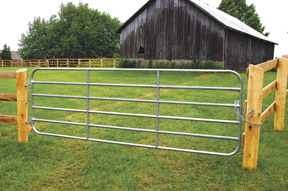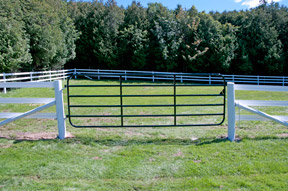
This mesh design will prevent horses from putting a hoof through the gate.
When designing a paddock for horses, safety and ease are the most important aspects to keep in mind. When it comes to adding gates, they should be designed to be used safely and efficiently when moving horses in and out of paddocks. As most of us have witnessed, most horses tend to gather near gates while waiting for feed or when it’s time to come inside. This can constantly put pressure on the gates, which is what you do not want. Therefore, it is critical that you are aware of what type of gate to purchase for your fencing as gates should have the same strength and safety elements as your fencing.
Design
Paddock gates can be easily purchased or built in just as many styles as fencing. They do not need to be built out of the same material as your fencing, but must be the same height in order to discourage horses from reaching over or trying to jump the gate.
They can include many features such as:
- Round edges or rectangular in shape
- Mesh, board, metal tube or nothing in the middle
- Varying lengths and heights
One of the most important aspects of the gate is the length because it can very difficult to altar once installed. If your paddock is simply meant for horses to graze and exercise, a six- to eight-foot gate should be more than enough, as small farm equipment such as garden tractors or ATVs can also fit through this space. For a farm that has larger tractors or would like vehicle access to their paddocks, a 12- to 16-foot gate should be sufficient.
One suggestion is to avoid using gates with diagonal cross bracing. Even though it increases the strength of gates, the narrow angles can trap curious horses’ legs, feet and even heads.

This galvanized steel gate is long enough to allow large equipment to enter the paddock.
Material
Paddock gates can be built out of a variety of materials; however the most recommended material is metal round tube. Square or diamond tube gates can have multiple sharp edges that could lead to injury. Therefore, we recommend using round tube gates, as they do not have the sharp edges. It is imperative that gates be built with sturdy construction and be highly visible in order to withstand the constant pressure from horses gathering near or around the gate and that they hold up to everyday farm usage. Make sure to use a heavy gauge gate and products that are intended for gate use only.
Gate latches are equally as important because we all know how challenging it can be opening a gate and leading a horse at the same time. The heavy duty One Way and Two Way latches can easily be operated with one hand, even while on horseback. Both the locking and non-locking models keep horses in pastures and away from busy roads. Another option is to install a quick latch that is rust and freeze proof and can also be easily operated. Always make sure that you have the correct hinge bolts for the size and weight of your gate. The use of gate wheels when opening and closing will help to prevent sagging when using longer gates. Overall, paddock gates must be able to withstand the constant challenges of leaning horses and many years of abuse as well as being conveniently operable.
Additionally, if you find your horses are leaning and chewing on your gate, you could install an electric line across your gate with a Gate Handle and Bungee Gate Kit.

Make sure the gate is hung level and secure on your posts.
Positioning
Most paddock gates are positioned to swing into the usual pressure of the horses in order to prevent them from pushing the gate open and damaging the latches. Gates can also be installed to swing both into and out of fields, which can be helpful when turning out horses. For maximum convenience, it is suggested to position your gate as close to the entrance of your barn as possible. This will save a lot of time and also make moving the horses much easier for everyone.
When positioning your gate it is important to not situate it at a low spot in your paddock. This is where most of the run-off accumulates and can leave fields very soggy and muddy in spring and winter so it is best to install the gate in a more elevated location. Additionally, placing a gate in the corner of your field can reduce a bit of financial stress when planning your paddock. Since the corner will already require bracing and possibly concrete for stabilization, this positioning would cut down on extra bracing posts.
Overall, you want to guarantee that your horses are safe and secure when in their paddocks and putting in the effort to find the most appropriate gate for your fence can help accomplish that. Keep these tips and recommendations in mind when installing your gate and they can help save you significant time and energy in the future.
